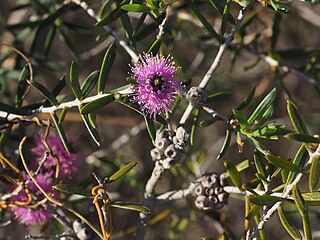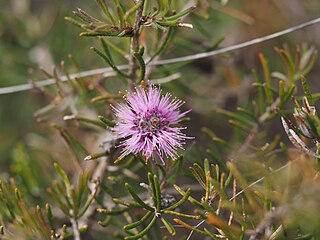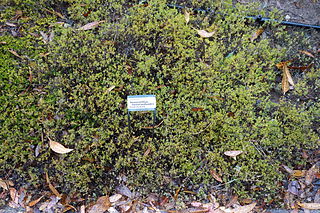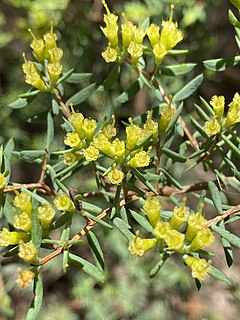
Homoranthus is a genus of about thirty species of plants in the myrtle family Myrtaceae and all are endemic to Australia. Plants in this genus share similarities with those in both Darwinia and Verticordia. They are shrubs with their leaves arranged in opposite pairs and with flowers appearing either singly or in small groups, usually in upper leaf axils. They are found in Queensland, New South Wales and South Australia. The genus was first described in 1836. None of the species is common nor are they well-known in horticulture.

Melaleuca linearifolia, commonly known as netted bottlebrush, is a plant in the myrtle family, Myrtaceae and is endemic to New South Wales in Australia.. It is a shrub with narrow, pointed leaves and red flower spikes in spring or summer.

Melaleuca caeca is a plant in the myrtle family, Myrtaceae and is endemic to the south-west of Western Australia. It is similar to a number of other Western Australian melaleucas such as M. pentagona with its purple pom-pom flower heads but it is a smaller shrub with narrower leaves and smaller inflorescences.

Melaleuca halophila is a plant in the myrtle family, Myrtaceae and is endemic to the south of Western Australia. It is a prickly shrub, similar to Melaleuca thapsina but its flowers are white and the leaves are shorter and hairier.

Melaleuca interioris is a plant in the myrtle family, Myrtaceae and is endemic to Western Australia, South Australia, Queensland, New South Wales and the Northern Territory. It was formerly included in Melaleuca uncinata and is similar to that species with its cylinder-shaped leaves and small heads of yellow flowers, but with smaller, less compressed fruiting capsules.
Melaleuca procera is a plant in the myrtle family, Myrtaceae and is endemic to the south-west of Western Australia. It is an erect, spindly shrub with cylinder-shaped leaves and heads of pinkish flowers in later spring or early summer.

Melaleuca societatis is a plant in the myrtle family, Myrtaceae and is endemic to the south west of Western Australia. It is a dwarf shrub with small, fleshy leaves and many heads of pink or purple flowers in spring, followed by "soccer-ball" fruit.

Melaleuca thapsina is a plant in the myrtle family, Myrtaceae and is endemic to the south-west of Western Australia. It is a prickly shrub with fibrous or papery bark, yellow to cream coloured flowers and tightly packed cylinders of fruiting capsules.

Melaleuca tinkeri is a plant in the myrtle family, Myrtaceae and is endemic to the south-west of Western Australia. It is one of the smallest melaleucas and is distinguished by its warty, hairy leaves, heads of pinkish flowers in late winter to spring and its spherical fruiting clusters.

Melaleuca wonganensis is an erect shrub in the myrtle family Myrtaceae and is endemic to the south-west of Western Australia. It is a shrub with narrow leaves and purple to deep mauve flowers and is restricted in its distribution to the Wongan Hills district.

Homoranthus homoranthoides is a plant in the myrtle family Myrtaceae and is endemic to South Australia.

Melaleuca acuminata, commonly known as mallee honeymyrtle is a plant in the myrtle family, Myrtaceae and is native to Australia and widespread in temperate areas of the continent. It is an erect shrub to about 3 m (9.8 ft) usually found in mallee woodland.
Melaleuca fulgens subsp. fulgens, commonly known as the scarlet honey myrtle, is a plant in the myrtle family, Myrtaceae and is endemic to the south-west of Western Australia. In 1990, the species Melaleuca fulgens was separated into 3 subspecies and this is the most widespread of them. As with the other two subspecies, this one is notable for its showy flowers which are usually red but its foliage and fruits are also attractive features.

Homoranthus biflorus is a flowering plant in the family Myrtaceae and is endemic to a small area in northern New South Wales. It is an erect shrub with cylinder-shaped leaves and small groups of usually yellow flowers.
Homoranthus elusus is a plant in the myrtle family Myrtaceae and is endemic to a small area on the Northern Tablelands of New South Wales. It is an shrub with linear leaves and with groups of up to four flowers in leaf axils. It is only known from a single specimen collected near Tenterfield.

Homoranthus lunatus, commonly known as crescent-leaved homoranthus, is a flowering plant in the family Myrtaceae and is endemic to a small area in northern New South Wales. It is a spreading shrub with curved leaves and small groups of up to six yellow flowers in leaf axils.

Homoranthus porteri is a plant in the myrtle family Myrtaceae, and is endemic to a small area in northern Queensland, Australia. It is an upright shrub with creamy-white to red pendulous flowers in pairs on a short stalk with red bracts and small linear leaves.

Homoranthus prolixus, commonly known as granite homoranthus is a flowering plant in the family Myrtaceae and is endemic to northern New South Wales. It is a spreading shrub with linear to lance-shaped leaves and groups of up to six yellow to red flowers in the upper leaf axils.

Homoranthus thomasii is a species of flowering plant in the family Myrtaceae and is endemic to Queensland. It is a small shrub with spoon-shaped, greyish green leaves and small, pendulous, pink flowers in the upper leaf axils.

Homoranthus zeteticorum is a flowering plant in the family Myrtaceae and is endemic to a small area in central Queensland. It is a tall shrub with axehead-shaped leaves and pendulous flowers with darker styles.


















